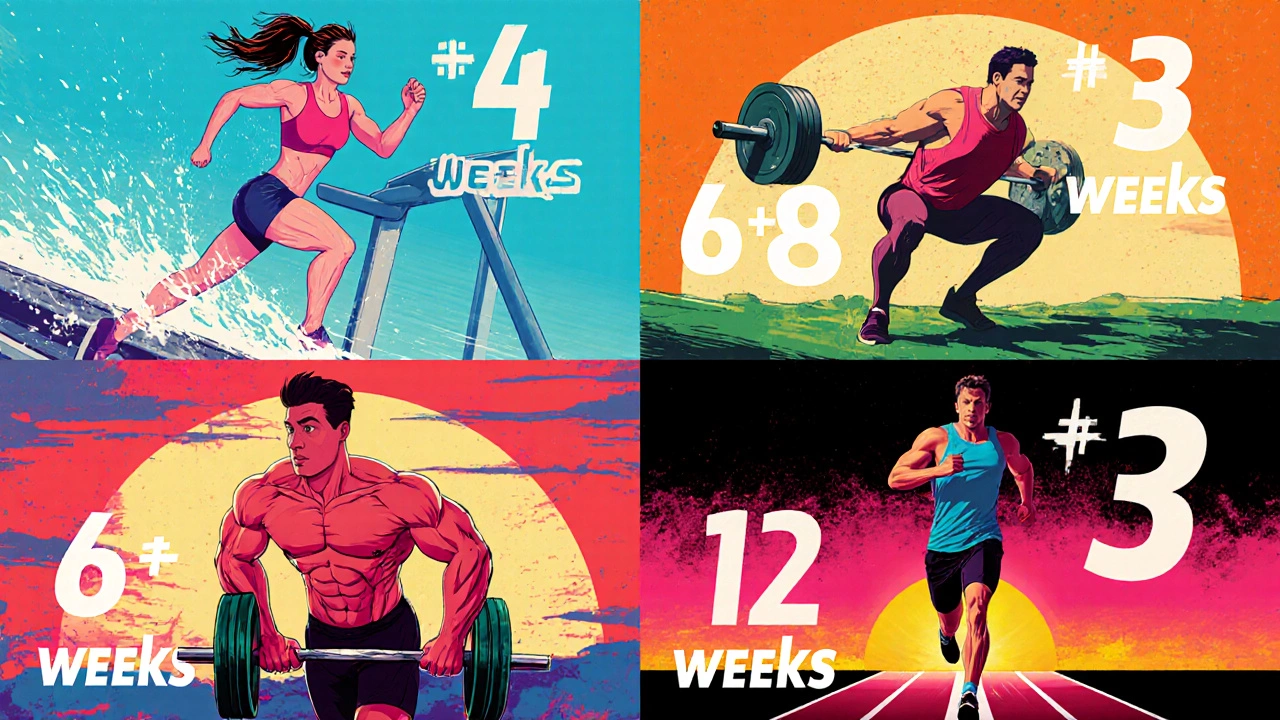
Fitness Results Estimator
Estimate Your Results Timeline
You’ve signed up with a Personal Trainer is a certified fitness professional who designs, monitors, and adjusts your workout plan to match your goals. The big question on everyone’s mind is: how soon will those changes show up on the scale, in the mirror, or in the gym? Below we break down the science, the typical timelines, and the hidden factors that can speed up or stall your journey.
What Influences the Speed of Results?
Results don’t appear in a vacuum. A Client is the person who brings motivation, consistency, and personal history into the equation. Six key variables shape the timeline:
- Baseline fitness level - Beginners often see faster initial gains because their bodies are adapting to new stress.
- Goal specificity - Losing 10 kg, adding 20 kg to a squat, or shaving 5 % off body fat each demand different adaptation periods.
- Program design - A well‑structured Training Program balances progressive overload, periodisation, and recovery.
- Nutrition - Nutrition Guidance ensures calories, macros, and micronutrients support the specific goal.
- Commitment & consistency - Skipping sessions or deviating from the plan adds weeks to any timeline.
- Individual genetics - Hormonal response, muscle fiber composition, and recovery speed differ from person to person.
Typical Timelines by Goal
Below is a rule‑of‑thumb guide based on data from the National Strength & Conditioning Association and a 2023 meta‑analysis of 1,200 personal‑training case studies. Remember, these are averages; your personal experience may vary.
| Goal | Typical Visible Change | Key Metrics Tracked | Factors That Can Accelerate |
|---|---|---|---|
| Weight loss (5‑10 % body fat) | 4‑6 weeks | Body composition, waist circumference | Calorie deficit >500 kcal/day, HIIT sessions |
| Strength increase (e.g., squat +20 kg) | 6‑8 weeks | 1RM tests, rep max progression | Linear periodisation, adequate protein (1.6‑2.2 g/kg) |
| Muscle hypertrophy (2‑3 % muscle mass) | 8‑12 weeks | Muscle girth, ultrasound, DEXA | Progressive overload, 48‑72 h rest per muscle group |
| Cardiovascular endurance (5‑km run < 25 min) | 5‑7 weeks | VO₂ max, run time | Interval training, consistent weekly mileage |
How a Personal Trainer Structures the Journey
Every successful partnership begins with a Fitness Assessment that captures baseline data: body weight, body composition, movement quality, and cardiovascular markers. From there, the trainer creates a roadmap that typically follows three phases:
- Adaptation Phase (Weeks 1‑3) - The body learns new movement patterns, neural activation improves, and initial soreness is expected. Progress is measured with simple strength tests and mobility scores.
- Progression Phase (Weeks 4‑12) - Load, volume, or intensity is incrementally increased. This is where most people see the first real personal trainer results in the mirror or on the scale.
- Optimization Phase (Weeks 13+) - Fine‑tuning, deload weeks, and specific performance peaks are introduced. At this stage, metrics like Body Composition shifts become more subtle, but strength gains and endurance improvements can continue for months.
Throughout each phase, a trainer relies on Progress Tracking tools - gym logs, mobile apps, or simple spreadsheets - to keep both parties honest. Real‑time feedback allows immediate adjustments: swapping a squat for a deadlift if the client is stalling, or adding a mobility drill if range of motion is limited.

Measuring Progress Beyond the Scale
Numbers tell a clearer story than feelings alone. Here are the most reliable indicators:
- Strength benchmarks - 1RM or 5RM tests for squat, deadlift, bench press.
- Body composition analysis - DEXA scans, bioelectrical impedance, or skin‑fold measurements.
- Performance metrics - Time to run 5 km, number of push‑ups in 60 seconds, or VO₂ max.
- Visual cues - Before‑after photos taken under the same lighting and clothing.
When a trainer logs these data points every 4‑6 weeks, patterns emerge, and you can celebrate micro‑wins instead of waiting for a dramatic transformation.
Common Pitfalls That Delay Results
Even the best trainer can’t overcome a client’s hidden obstacles. Watch out for these:
- Inconsistent attendance - Missing more than two sessions a month adds roughly 2‑3 weeks to any timeline.
- Poor sleep - Less than 6 hours/night hampers hormone balance, slowing muscle repair.
- Neglecting nutrition - Skipping meals or over‑indulging on cheat days erodes calorie deficits needed for weight loss.
- Skipping deload weeks - Constant high‑intensity training can trigger over‑training syndrome, causing plateaus.
Addressing these issues early-through education, habit‑building, and realistic goal‑setting-keeps the timeline on track.

Quick Checklist for Faster Results
- Complete a thorough Fitness Assessment before starting.
- Set a specific, measurable goal (e.g., "Lose 5 kg in 8 weeks").
- Follow the trainer’s Training Program exactly for the first 4 weeks.
- Track calories and protein using a reliable app; aim for 1.6‑2.2 g protein/kg body weight.
- Sleep 7‑9 hours per night; treat recovery as part of the program.
- Log every workout in a Progress Tracking sheet; review every 4 weeks.
- Schedule a reassessment after the Adaptation Phase to adjust loads.
Frequently Asked Questions
How many sessions per week are needed to see results?
Most clients see noticeable changes after 3‑4 sessions per week for the first 6‑8 weeks. Fewer sessions can work if the program includes high‑intensity home workouts and strict nutrition.
Can I achieve results without a personal trainer?
You can, but a trainer shortens the learning curve. They provide accountability, correct form, and program progression, which typically shave 4‑6 weeks off the timeline.
What if I stop after I see the first changes?
Stopping early often leads to regression. Your body adapts to the stimulus; maintain at least a maintenance routine and keep nutrition in check to lock in gains.
How is progress measured for beginners versus advanced clients?
Beginners rely on rapid neuromuscular improvements (easier reps, better technique) while advanced clients focus on marginal strength lifts, muscle symmetry, and metabolic efficiency.
Do I need special equipment to see results?
A basic set of dumbbells, a bench, and a resistance band cover most programs. Trainers can adapt workouts to bodyweight or limited gear without sacrificing results.
In short, expect the first visible shift between 4‑8 weeks, but true transformation is a marathon, not a sprint. By aligning your expectations with the science, staying consistent, and partnering with a knowledgeable trainer, you’ll turn those early wins into lasting change.
